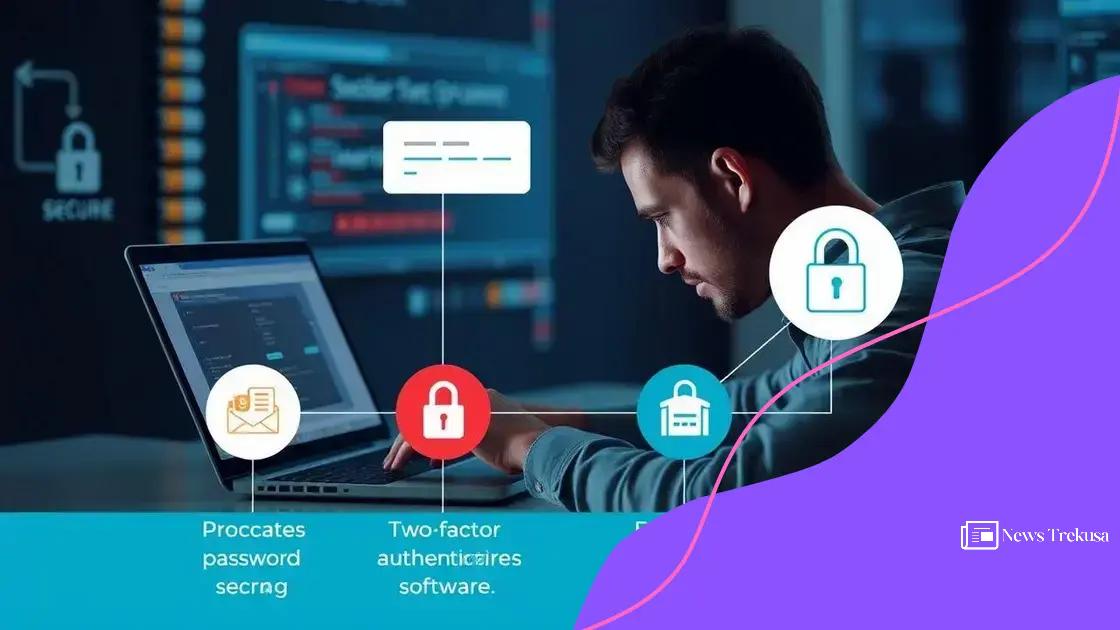Cybersecurity threats and responses: how to stay safe online

Cybersecurity threats and responses encompass various attacks such as malware, phishing, and ransomware, requiring businesses to adopt strong security measures, employee training, and advanced technologies to effectively protect sensitive data.
Cybersecurity threats and responses have become a crucial topic for everyone in today’s digital landscape. Whether you’re a casual internet user or run a business, having a grasp on these threats is essential. Let’s delve into what you need to know to safeguard your information.
Understanding cybersecurity threats
Understanding cybersecurity threats is crucial in today’s digital world. With technology advancing, it’s important to know the different risks that can affect personal and business information.
Common Cybersecurity Threats
Some common cybersecurity threats include:
- Malware: Malicious software that can harm devices.
- Phishing attacks: Deceptive emails or messages designed to steal personal information.
- Ransomware: A type of malware that locks users out of their files until a ransom is paid.
- DDoS attacks: Overwhelming a server with traffic, causing it to crash.
Each of these threats targets weaknesses in systems and can lead to serious consequences, including loss of data and financial loss. For instance, phishing is often disguised as legitimate communication, making it hard to detect. Being aware of these tactics helps users stay vigilant.
Why Understanding These Threats Matters
Awareness is the first step to protection. When individuals and businesses recognize the types of threats they face, they can implement effective strategies to defend against them. Simple actions, such as updating software regularly and using strong passwords, can significantly enhance security.
Moreover, educating employees about cybersecurity threats fosters a culture of security awareness within organizations. This engagement not only helps protect sensitive data but also builds trust with customers, who seek assurance that their information is safe.
As technology evolves, so do the methods used by cybercriminals. Staying informed about the latest threats and adopting proactive measures are essential for maintaining security in an ever-changing landscape.
In summary, understanding cybersecurity threats plays a vital role in safeguarding personal and sensitive information. By being aware of the potential risks and implementing the necessary defenses, individuals and businesses can significantly reduce their exposure to cyber attacks.
Common types of cyber attacks
Common types of cyber attacks can affect anyone online. Understanding these threats is vital for ensuring safety in the digital world. Knowing how these attacks work can help you stay protected.
Types of Cyber Attacks
Some prevalent forms of cyber attacks include:
- Malware: This malicious software infects your device and can steal or damage files.
- Phishing: Cybercriminals use fake emails or messages to trick individuals into revealing personal information.
- Ransomware: A harmful type of software that locks your data until you pay a ransom.
- DDoS Attacks: Attackers flood a network with traffic, making it unavailable to users.
These attacks can have serious consequences, including financial loss and data breaches. For instance, ransomware can leave businesses paralyzed if they cannot access crucial files. It’s essential to maintain robust security measures to ward off these threats.
Signs of a Cyber Attack
Recognizing the signs of a potential attack can help you respond quickly. If you detect your device performing unusually or your accounts seem compromised, take immediate action. Here are some indicators:
- Unexplained changes in account access.
- Sudden slowdowns in device performance.
- Frequent pop-up ads or unusual error messages.
Staying alert to these signs can help prevent a minor issue from escalating into a significant problem. Investing in security software and regularly updating passwords can make a big difference.
As cyber attacks evolve, it is important to stay informed about new threats. Regular training and awareness of cybersecurity can significantly increase preparedness and response rates.
Best practices for online security

Best practices for online security are essential for protecting your personal information and privacy. With cyber threats on the rise, knowing how to secure your online presence can help you avoid becoming a victim.
Strong Passwords
Using strong passwords is one of the simplest yet most effective ways to enhance security. A strong password should:
- Include a mix of letters, numbers, and special characters.
- Be at least 12 characters long.
- Avoid using easily guessed information like birthdays or names.
Changing passwords regularly and using different passwords for different accounts is also recommended. This reduces the risk of multiple accounts being compromised at once.
Two-Factor Authentication
Another vital security measure is enabling two-factor authentication (2FA) wherever possible. 2FA adds an extra layer of protection by requiring something you know (your password) and something you have (a mobile device). This makes it much harder for attackers to gain access to your accounts.
When using public Wi-Fi, always connect through a virtual private network (VPN). A VPN encrypts your internet traffic and makes it more difficult for hackers to intercept your data. It’s important to remain cautious and look out for unsecured networks.
Regularly updating software is also crucial for maintaining security. Developers frequently release updates to patch vulnerabilities that could be exploited by cybercriminals. Keeping your operating system, apps, and antivirus software updated can significantly enhance your defense against attacks.
Educating Yourself
Being informed about the latest cyber threats can help you prepare and respond effectively. Following cybersecurity news and participating in training sessions will keep your knowledge fresh. Knowing how to identify phishing attempts and suspicious links equips you to safeguard your information better.
By applying these best practices for online security, you can create a robust defense against various cyber threats. It’s all about being proactive and diligent in your approach to protecting your digital life.
How businesses can respond to breaches
Businesses need to have a solid plan for how they can respond to breeches. Recognizing the best approaches can minimize damage and restore trust with customers and stakeholders. Having a response strategy is crucial for any organization.
Immediate Steps to Take
When a breach is detected, the first step is to contain the situation. This may involve shutting down affected systems or isolating impacted networks to prevent further data loss. After containment, it’s essential to assess the extent of the breach. Understand what data was compromised and identify the systems that were affected.
- Quickly inform management and relevant stakeholders.
- Document all actions taken during the response.
- Consult the incident response team if available.
These immediate actions can help in limiting the scope of the breach. Additionally, controlling communication is vital. Always provide accurate information without speculation to avoid damaging the company’s reputation further.
Notifying Affected Parties
Once the immediate threat is under control, businesses must notify affected individuals as soon as possible. This includes customers, employees, and partners who may have had their personal information compromised. Transparency during this process builds trust.
Additionally, providing resources, such as credit monitoring services, can help affected parties manage the repercussions of the breach.
Revising Security Measures
After addressing the immediate breach, businesses should take time to review and revise their security measures. This includes:
- Conducting a thorough security audit.
- Updating software and systems to the latest versions.
- Implementing stronger access controls.
Regular training for employees on security practices should also be part of this process. Strengthening employee awareness of potential threats helps in building a robust defense against future attacks.
Investing in new technologies or services helps fortify defenses even further. Cybersecurity is ever-evolving, and adapting to new threats should be an ongoing process.
Future of cybersecurity measures
The future of cybersecurity measures is looking more advanced as technology continues to evolve. Staying ahead of cyber threats requires constant adaptation and innovation. As cybercriminals become more sophisticated, so must our defenses.
Emerging Technologies
New technologies are playing a key role in enhancing cybersecurity. For example, the use of artificial intelligence (AI) is transforming how threats are detected and responded to. AI can analyze vast amounts of data to identify patterns that may indicate a security breach.
- Machine Learning: Algorithms learn from data and improve their accuracy over time.
- Blockchain: This technology provides secure, decentralized records, making it harder for hackers to alter data.
- Quantum Cryptography: Exploits the principles of quantum mechanics to enhance secure communication.
These innovations show promise in making systems more resistant to attacks. Investing in these technologies can help organizations fortify their security posture.
Increased Focus on Privacy
As data privacy becomes a growing concern, businesses are putting more emphasis on protecting customer information. Regulations like the General Data Protection Regulation (GDPR) inspire companies to enhance their cybersecurity measures.
Organizations are now implementing stricter data management policies. This includes:
- Minimizing data collection.
- Conducting regular audits.
- Training employees on privacy practices.
By prioritizing privacy, companies can build trust with their customers while reducing the risk of data breaches.
The Role of Cybersecurity Awareness
As threats grow more sophisticated, fostering a culture of cybersecurity awareness is vital. Training employees to understand potential risks can prevent many breaches from occurring. Regular training sessions can cover the latest threats and best practices.
Engaging staff in cybersecurity practices increases their ability to recognize potential attacks, such as phishing. An informed workforce acts as a first line of defense against cyber threats.
In summary, the future of cybersecurity measures will rely heavily on emerging technologies, a strong focus on privacy, and an informed workforce. These elements will be critical in responding effectively to the ever-evolving landscape of cyber threats.
FAQ – Frequently Asked Questions about Cybersecurity Measures
What are the most common types of cybersecurity threats?
The most common types include malware, phishing attacks, ransomware, and DDoS attacks.
How can businesses protect themselves from data breaches?
Businesses can protect themselves by using strong passwords, enabling two-factor authentication, and training employees on security practices.
What role does technology play in enhancing cybersecurity?
Emerging technologies like AI and blockchain are crucial for detecting threats and enhancing data protection.
Why is employee training important in cybersecurity?
Training helps employees recognize potential threats and respond appropriately, acting as a first line of defense against cyber attacks.
SEE MORE CONTENT